Gilbert Park tests the new Buoycatcher-Max, the next generation boat hook
Buoycatcher-Max: We test the next generation boat hook
The new Buoycatcher-Max is the next step up from a traditional boat hook.
It enables you to feed a mooring line through a ring on top of a buoy by attaching the line to the eye of the device’s jaw.
You then push the jaws through the ring before pulling back to allow the line to pass effortlessly through the ring and then back to the boat.

The jaws of the Buoy Catcher attached to the pole (notice the red locking levers) and the boat hook attachment. The mooring line is attached to the eye in the jaws. Credit: Gilbert Park
As I mostly sail solo or with non-boating friends, devices like these make life much easier.
The first thing that struck me was the robust nature of the Buoycatcher-Max.
The three-part handle is made of aluminium with decent cam locking clips.
Fully extended it is 3.17m; closed it is 1.16m, about the same as a normal boat hook.
The handle weighs 1kg and has a long non-slip covering at its base.
The Buoycatcher-Max’s removable jaws are nicely made from 316 stainless steel and weigh 0.5kg.
Other attachments – a traditional boat hook, brush and magnet – can also be fitted.
So what was it like in use?
I found it worked well, enabling me to easily pass a rope through a buoy, cleat and ladder from much further away than my previous boat hook, ideal for those moments when you’re almost there, but a gust of wind or a wave takes the boat away at the last moment.
It is heavier than my normal boat hook, especially when used at full extension and some might find that off-putting when using it horizontally. However, from the bow when you are using it vertically, this is less of a problem.
There are a few minor niggles.

The Buoycatcher-Max also works to feed a rope through a cleat on the deck. Credit: Gilbert Park
I am not a fan of hand loops on boat hooks; I’ve seen people dragged into the water if the hook jams or catches and the boat continues to move.
However, I would have liked the opportunity to put a line on (without a loop) just to wrap around my wrist.
Because the jaws (and other accessories) are screwed in they can work loose In one stressful situation (we all have them) my crew couldn’t get the jaws to work because they kept turning around.
This is easily fixed by just testing the accessory before use.

Here is the Buoycatcher-Max stowed next to an extending boat hook. Both are of a very similar size. The boat hook extends to 2m and locks in place at that point. The Buoycatcher-Max extends to 3m, but can be any length from 1m upwards because of the cam locks. Credit: Gilbert Park
At £170 it is, at first sight, an expensive piece of kit, several times the cost of similar-looking items on eBay.
However, this is a quality piece of equipment that will last many years and is much less likely to fail at a critical moment.

The aluminium pole is in three parts each approximately one meter long, so fully extended the pole is over three meters long. Credit: Gilbert Park
The jaws are a nice piece of engineering and the handle, with its long reach, locks and doesn’t undo.
Should the handle wear, the cam locks are adjustable to compensate.
Contact: buoycatcher.com




